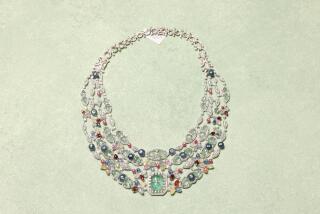Rough Trade Tarnishes World of Rough Diamonds
- Share via
In 1998, Global Witness, a London-based nongovernmental organization that focuses on the links between environmental and human-rights abuses, published a groundbreaking report on “conflict” or “blood diamonds.”
The report documented how trade in rough diamonds has funded and prolonged conflicts in Angola and Sierra Leone. De Beers and Global Witness define “conflict diamonds” as those that originate from areas in Africa controlled by forces fighting against legitimate governments. Small, valuable, and easily concealed, many of these diamonds have fueled resistance for years and found their way into the legitimate diamond industry.
The report focused particularly on De Beers and its subsidiaries. In 1996, De Beers was sorting, valuing and selling about 80% of the world’s diamond production. Today, this figure stands at about 65%, since new mines owned by other companies in Australia and Canada have increased the diamond supply.
According to Global Witness, De Beers’ annual reports during the 1990s make it clear the company was buying rough diamonds in Angola at a time when the country was engaged in a long and bloody civil war.
Conflict diamonds are estimated to constitute 3% to 4% of the world’s diamond supply. But the diamond industry was not about to allow the issue to overshadow the carefully cultivated image of diamonds and romance.
In 1999, De Beers announced an embargo on all diamonds from Angola by its buying offices around the world. Sierra Leone was later added to the list. In 2000, producers, manufacturers, traders, diamond companies and others formed the World Diamond Council to develop a system to track the export and import of rough diamonds to prevent their exploitation for illicit purposes.
Governments, industry and nongovernmental organizations have tried to develop a system to ensure that conflict diamonds do not enter the legal trading system. Last year, the U.S. House of Representatives passed a version of the Clean Diamond Trade Act, which provides the president authority to block rough diamond imports from countries that do not have safeguards against the trade in conflict diamonds. The bill is pending in the Senate.
William Boyajian, president of the Gemological Institute of America, said he remembers the conference he attended at the State Department several years ago when conflict diamonds were first brought up. “Frankly, I think it was news to a lot of people,” Boyajian said. “Even to someone like me, who has been in the business 25 years. I think the industry was first shocked, then angry, because what about oil, what about arms [in terms of fueling conflicts] until very soon after that, the clearer reality emerged that if this was going on it was something the industry wanted to confront.”
Most jewelers said consumers appear unaware or unaffected by the issue. Jeweler’s Circular Keystone, an industry trade publication, conducted a survey about a year ago asking retail jewelers if their customers ever mentioned “conflict diamonds.” Of 223 respondents, 85.7% of jewelers said their customers did not ask; 14.3% said they had received inquiries. “There are certainly some folks, particularly in areas where there is a tendency to latch onto a cause du jour, who will eschew diamonds,” said Hedda Schupak, editor of Jeweler’s Circular Keystone.
“But as an industry observer, I don’t see it as a trend across the nation.”
More to Read
Sign up for Essential California
The most important California stories and recommendations in your inbox every morning.
You may occasionally receive promotional content from the Los Angeles Times.












